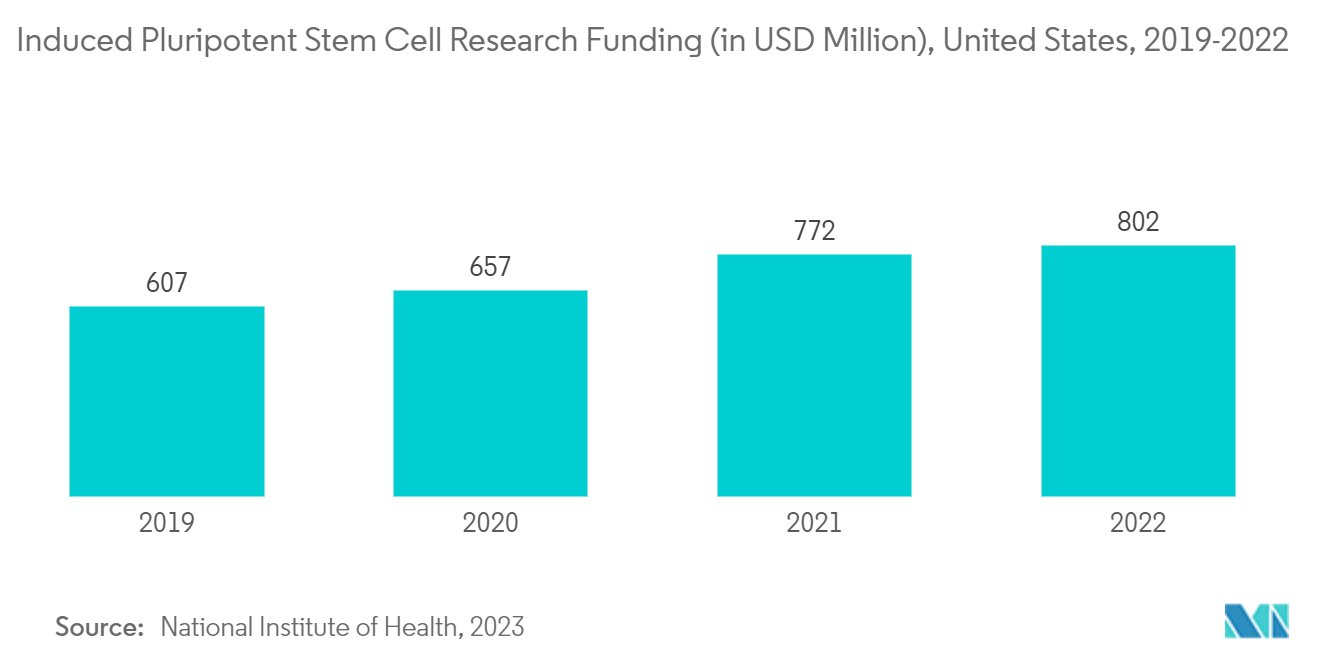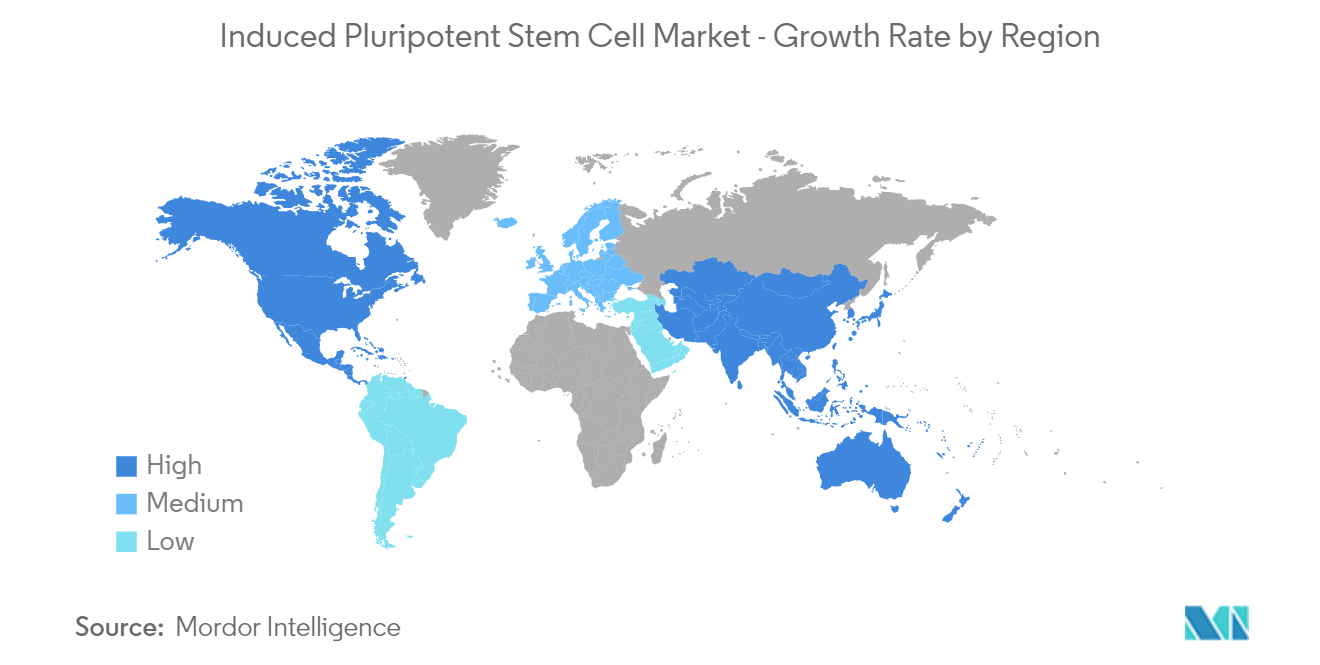Market Trends of Induced Pluripotent Stem Cells Industry
Regenerative Medicine Segment is Expected to Witness Significant Growth Over the Forecast Period
iPSCs are the cells that are reprogrammed from somatic cells using different transcription factors and these cells possess unique properties of self-renewal and can differentiate into a variety of cell lineages. In regenerative medicine, damaged or degenerating tissues are restored by being produced in labs with the aid of iPSCs and then transplanted to the location of the damage or degeneration. Additionally, iPSC offers several advantages over other stem cell types in models of regenerative medicine and wound healing as they are produced from adult somatic cells rather than embryos. Thus, iPSCs are not associated with the ethical concerns that surround the use of embryonic stem cells.
The regenerative medicines segment is expected to witness significant growth in the induced pluripotent stem cells market over the forecast period owing to the factors such as the rising adoption of iPSCs in regenerative medicine research and increasing company activities.
The increasing number of research studies related to induced pluripotent stem cells is the key factor driving the market growth. For instance, according to a study published by Indiana University, in May 2022, the researchers at Indiana University School of Medicine in collaboration with the University of Alabama at Birmingham and five other institutions investigated novel regenerative medicine techniques to better manage vascular health complications, especially in a retinal vessel, caused by type 2 diabetes. The results show that a specific mesoderm subgroup formed from hiPSCs can be safely, effectively, and persistently derived for use as a new therapeutic to rescue ischemic tissues and repair blood vessels in people with vascular disorders. Additionally, the same source stated that the researchers genetically transformed diabetic and non-diabetic peripheral blood cells into hiPSCs, maturing the cells into unique blood vessel reparative cells, for the multi-site early phase study. With the restoration of vascular perfusion, the effects of injection into animal models of type 2 diabetic mice (T2D) retinal dysfunction demonstrated a considerable improvement in visual acuity and electroretinograms. Thus, the iPSCs' results in treating diabetic patients' retinal impairment have increased their use in study design and cell therapy for human disorders, hence propelling market growth.
Furthermore, the increasing government funding to promote the production of stem cell-based therapies for treating various diseases as well as establishing stem cell research centers are expected to increase its adoption, hence propelling the market growth. For instance, as per the Australian Government Department of Health and Aged Care, in March 2022, the Stem Cell Therapies (SCT) Mission invested USD 150 million in the development of novel, secure, and efficient stem cell therapies to increase health outcomes. The mission provides funding for initiatives that develop innovative, safe, and efficient medical therapies that enhance patient well-being, workforce productivity, and the development of commercial stem cell products.
Moreover, the rising company activities in developing regenerative medicines using iPSC are also contributing to segment growth. For instance, in June 2022, SQZ Biotechnology Company generated dopaminergic (DA) neurons from human induced pluripotent stem cells (iPSCs), using the company's proprietary Cell Squeeze technology, through the single-step delivery of six RNA that encodes for specific fate-determining transcription factors. The new findings contribute to the company's recent presentations on regenerative medicine research and support its NIH-funded initiative to develop cell replacement therapeutics for neurological diseases including Parkinson's disease.
Therefore, owing to the aforementioned factors such as growing government funding for stem cell research and the rising number of research studies, the studied segment is expected to grow over the forecast period.

North America is Expected to Have the Significant Market Share Over the Forecast Period
North America is anticipated to hold a significant market share in the market over the forecast period owing to the factors such as the rising adoption of highly advanced technologies and systems in drug development, toxicity testing, and disease modeling, coupled with the growing acceptance of stem cell therapies in the region.
The growing research funding for iPSC research is also expected to propel market growth in the region. For instance, according to the data published by NIH, in May 2022, an estimated USD 740 million was funded by the government to support the research and development of stem cells-induced pluripotent stem cells in the United States in 2022, as compared to USD 713 million in 2021. Such a huge investment in iPSC is anticipated to increase its adoption, hence propelling market growth.
Moreover, the new product launches and facility-expanding activities by the company increase the availability of novel iPSC therapies in the market, which in turn is anticipated to augment the market growth. For instance, in May 2022, IN8bio, Inc. launched a new induced pluripotent stem cell (iPSC) based gamma-delta T cell platform at the American Society for Gene and Cell Therapy (ASGCT) Annual Meeting in Washington. This platform represents a new stage in IN8bio's development as it advances technology that is intended to allow for the scaled manufacturing of cellular therapies that are "off-the-shelf." Also, in April 2022, Ncardia launched Cellistic, a new business, to focus the company's induced pluripotent stem cell (iPSC) expertise on the cell therapy development and manufacturing sector. This strategy builds on the company's current drug discovery solutions business and takes advantage of the firm's in-depth expertise in iPSC differentiation and expansion to concentrate dedicated resources and capabilities to address the expanding demand for iPSC cell therapy solutions, including the development of reliable cell-specific manufacturing platforms.
Therefore, owing to the aforementioned factors, such as growing government funding for iPSC research and new product launches, the studied market is expected to grow over the forecast period.


